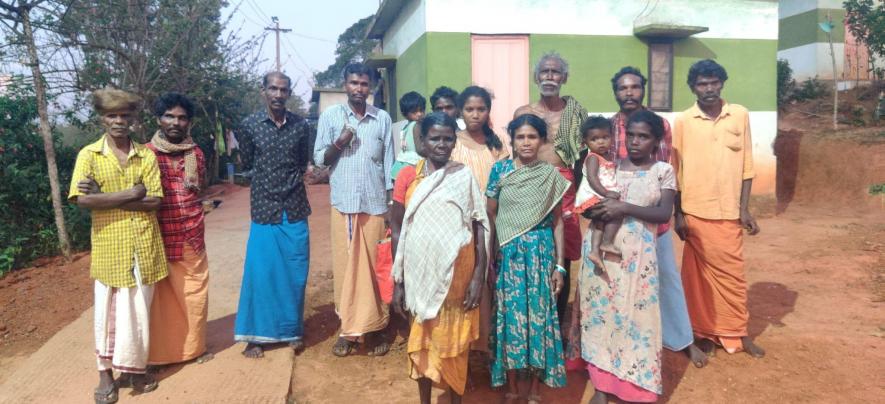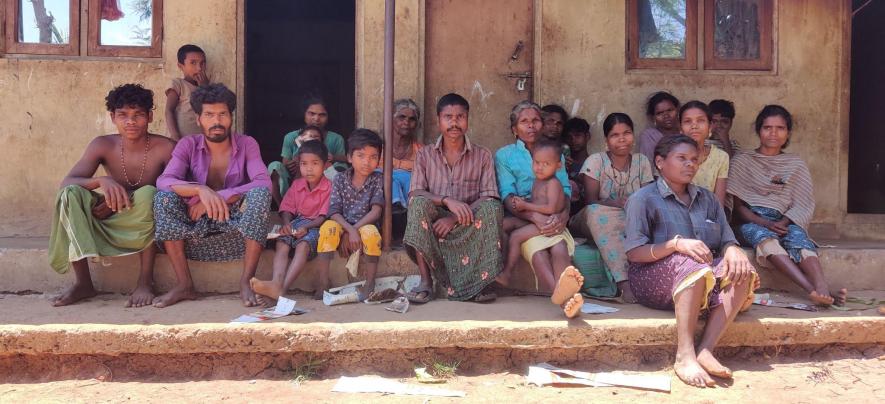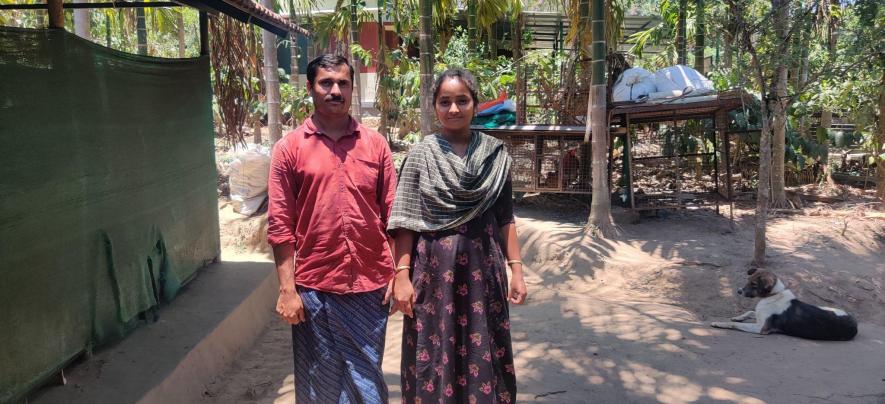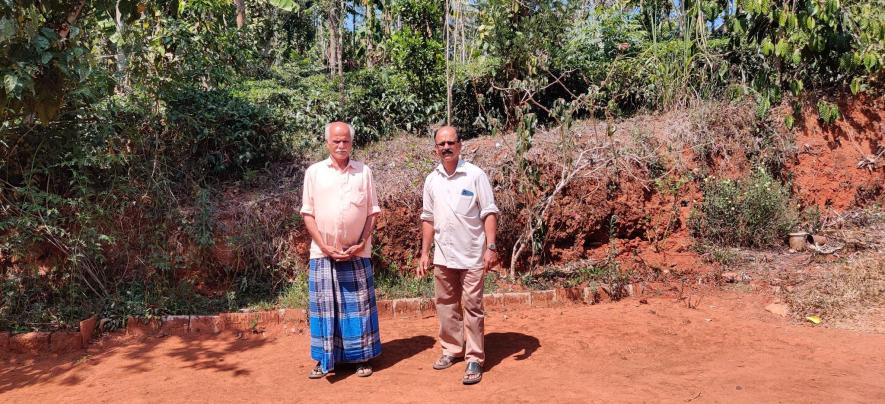
The breathtaking Mudumalai Tiger Reserve.
The Mudumalai Tiger Reserve (MTR) in Tamil Nadu is a vast expanse of breathtaking forest, home to several species of birds and animals. It is part of the Nilgiris biosphere reserve, which is an ecosystem of forests sharing boundaries with Kerala, Karnataka and Tamil Nadu. Four communities that live in the forest can trace their presence in the region at least 1000 years back. These are the Moundadan Chettys, Paniyans, Kattunayakans and Kurumbas.
A resettlement process for the communities has been underway since 2017. However, locals allege that middlemen and forest department staff managed to siphon off most of the money earmarked for the tribal communities.
The Moundadan (pronounced mount-adan) Chettys are not designated as tribals. They are classified as the Most Backward Communities (MBC) in the Tamil Nadu state Backward Classes list. The community speaks a local Dravidian language called Chetty. It has no script and is a mix of Tamil, Kannada and Malayalam. Among the four communities, only the Moundadan Chettys hold pattas (land titles) inside the Mudumalai Tiger Reserve (MTR). Compared to the tribals, the Chettys are better educated and are not intimidated by the prospect of going to court for redressal. In fact, it was the Moundadan Chettys who first approached the court in 1998 for resettlement outside the forest.
2007 High Court Judgement
In 1998, a member of the Moundadan Chetty community filed a writ petition (WP 18531) with the Madras High Court. The petitioner demanded that the court instruct the state government to provide resettlement and rehabilitation to the inhabitants of the Mudumalai wildlife sanctuary. He contended that development works had not been undertaken inside the forest since this was declared a wildlife sanctuary in 1954. Further, gun licences were not renewed, and the inhabitants could not save themselves or their crops from wild animals. There was also a threat to life from tigers and elephants. They wanted to be relocated to Ayyankolli, a village in the Nilgiris district but outside the forest boundary. The state government did not oppose the idea.
In view of conservation, the state government and the forest department supported the petition in the High Court. On February 19, 2007, the Madras High Court ordered the state government to complete the relocation process within a year. A few months later, the forest was co-incidentally declared a Tiger Reserve. The petitioners thought that they had won, they would be relocated, and their ordeal would be over.
However, the first phase of relocation took place only ten years later, in 2017, and it was far from smooth. The community members say that 235 chetty families were relocated in the first phase. However, no data is available about the number of tribal families that were relocated. They say that this was intentionally concealed because a coterie of middlemen, advocates and forest department officials siphoned off anywhere between 30%-100% of the compensation money that was earmarked for the tribal families.
NTCA Guidelines
As per the Guidelines of the National Tiger Conservation Authority (NTCA), there are two options for inhabitants who wish to relocate outside the core forest.
The first option is the payment of the entire package of Rs 10 lakhs per family. The second is relocation/rehabilitation outside the protected area by the forest department and a compensation package including two hectares of agricultural land per family.
In both cases, the District Collector (DC) must complete asset valuation in order to compensate the beneficiaries for the trees and crops which they would be leaving behind. Additionally, in the case of option 2, the forest department would have to identify an alternate site for resettlement and provide compensation for house construction. Families who hold pattas (land titles) are entitled to receive land for land outside the forest.
First Phase of Relocation in 2017
In the first phase of the relocation process, adivasis and chettys were not placed in common resettlement colonies. Instead, they were separated and dropped in different colonies at random. Newsclick visited one group of kattunayakans (also known as kattunayakars) residing in Palapalli hamlet. They were earlier residing in Bennai village inside the forest. The new location is close to the border and they face elephant encounters on a daily basis. Six years on, they regret their decision to leave and can’t wait to return to their forest home in Bennai.

The Kattunayakans moved to Palapalli hamlet in 2017.
The government has constructed homes for them in the Palapalli resettlement colony. However, even after six years, they don’t have piped water in their homes. They do have electricity and most homes have a TV. They say that Rs 7 lakh was paid to them as compensation, out of which, the forest department officials asked them to part with Rs 5 lakhs for their home. The balance amount of Rs 3 lakhs is supposedly in a fixed deposit account. As per NTCA rules, it was supposed to be withdrawn after three years and transferred to their savings account or to the account of any individual who has agreed to sell the land. Most of the adivasis are uneducated. The person who has studied the most in the Kattunayakan colony is a girl who reached 11th standard. But she, too, dropped out and didn’t complete her education.
The adivasis are in touch with a lawyer introduced to them by an organisation called Adivasi Munnetra Sangam. They are plotting ways to return to their forest home in Bennai, largely because of elephant encounters and a shortage of work. Here, they receive only nine-ten days of work as daily wagers. Their ration card is the only reason they are able to eat on a daily basis. But they have to spend Rs 200 for an autorickshaw to reach the nearest ration shop.
What hurts the adivasis the most is that the forest guards do not permit them to return to the forest to collect forest produce or to worship their deities. What makes their position even more vulnerable is that they were not given pattas (land titles) for their new homes. They cannot sell the houses and move to a different location. Already, the houses have started showing signs of decay. During the rainy season, the roof begins to leak so some families have tied a plastic sheet under the roof to collect rainwater.
NewsClick also witnessed two houses that were partially damaged. The adivasis say that it happened as elephants attempted to enter their rooms in search of food.
Second Phase of relocation in 2018
A tribal community called Paniyans (also known as Kattu Paniyars) were relocated from Mandakeri village inside the forest to a hamlet called Beechanakolly, just outside the forest border. This group of adivasis were part of the second phase of relocation in 2018.
Kollan, 34, is a member of the Paniyan community, which is designated as a Scheduled Tribe (ST). He said, “I used to live in the forest and had regular work in the local farms owned by members of the Moundadan Chetty community. I left the forest and moved to the resettlement area in 2018. Inside the forest, there is no electricity. There is a threat from elephants and tigers. We were promised facilities and Rs 10 lakhs to relocate from the forest. We thought it would improve our lives.”
Kollan and ten other tribal families agreed to relocate in 2018. However, they found to their horror, that the new location was not suitable for farming; it did not have fruits and other forest produce that they were familiar with. They were dropped on the edge of the forest, just outside the boundary and barred from re-entering.

The Paniyans are without work and desperate to return to their forest homes.
Kollan further said, “A forest ranger and an advocate who was part of the relocation committee showed us this piece of land and promised us an approach road, electricity and piped water facilities. They said that it (the land) belongs to a man called Janardhan. In reality, this land belongs to the government. We will not be given any patta (land titles) for it. All 11 families were paid Rs 7 lakhs as compensation by the forest department, out of which we paid around Rs 2.5 lakhs each for the land to Janardhan, and invested the rest into building houses for ourselves. In a short span of time, the money was exhausted.”
It is unclear whether the government can offer any assistance to these tribals. This is not an official resettlement colony. They were induced to buy land here by forest department officials and middlemen who spoke their language.
This colony has a narrow approach road. It is wide enough for walking but not for any vehicles. Aged persons have to be carried half a kilometre to reach the main road. The main concern is that they are out of work. They say that they have only two-three days of work per month.
The local guide said that the men spend most of their days sitting idle or drinking. Due to malnourishment, they are too weak to work in the farms on a daily basis. Almost no farm owner hires this group of tribals. This group is divorced from their community, their forest and their deity. Since they don’t have land titles in their possession, they cannot sell the land and move on. Effectively, they are trapped, and are without any prospects.
When asked about their deity, Kollan said, “the deity did not agree to leave the forest. When we called the deity, it told us that we should come there instead. We are not able to worship our deities anymore because the forest guards do not permit us to re-enter. Now, during our festivals, we take the katti (a large sickle), lantern and other materials generally used in the worship. We clean it and worship it. That’s all we can do. The trees and flowers needed for our religious celebrations are not found here. It has been five years since we saw our deity.”
The Moundadan Chettys in Muduguli Village
Muduguli village is inhabited by people who are still uncertain whether to leave the forest or not. It is a tiny hamlet located within the boundaries of the Mudumalai Tiger Reserve (MTR). There are several Moundadan Chetty families here. Their main occupation is farming. They have only one primary school in their vicinity, and it is a Tamil-medium, government school till 5th standard. They have to travel four-five kilometres on uneven terrain to reach the nearest health centre or ration shop.
Ambika, 38, is one of two Accredited Social Health Activists (ASHA) in MTR and has been a rural health worker for 12 years. She is from the Moundadan Chetty community. She lives in Muduguli village with her husband and two children. Speaking to NewsClick, she said, “The families who don’t own jeeps will have to carry the patient on a stretcher and walk until the (forest border) check post. There are no proper roads here, so ambulances cannot access this region. There is also a shortage of medical staff. I am the only medical worker for five villages. Moreover, I am only paid incentives, so my average earnings do not exceed Rs 2,000/month. Due to the relocation process, the population has reduced, and so has the number of pregnancies.”
Walking for four-five kilometres daily, Ambika performs her tasks with a broad smile on her face. Under the state government’s ‘Makkalai Thedi Maruthuvam’ scheme, she measures blood pressure and provides medicines for patients with serious illnesses at their doorstep. She takes notes on her visits and she has to update the completed work on a mobile phone app. Since there is no mobile network connectivity in most parts of MTR, she goes to the nearby panchayat office, which has a wifi facility. She is also part of the Centre of Indian Trade Unions (CITU) and had travelled to Chennai in February to protest in demand for job regularisation.
She says that the tribals are particularly fearful of going to hospitals and generally conceive at home. While she has witnessed several complications in the tribals’ home births, she did not feel comfortable narrating those stories on the record.

Ambika (R) and her husband Sivadass (L) outside their home in Muduguli.
Sivadass, 42, is Ambika’s husband. His farm is his main source of income. While he grows bananas, beans, ginger, pepper, coffee, arecanut and rice, his earnings largely rest on the crop of bitter gourd. This season, the yield has been good, and so has the rate. Speaking to NewsClick, he said, “The price of the bitter gourd has gone up to Rs 40/kg because a virus has been destroying the crop in the region. There is a lot of demand for vegetables in Kerala due to the Vishu festival.”
The biggest issue he faces is wild animals straying into his farm. He said that every farmer in MTR faces a great challenge – wild animals eating and destroying the crop as elephants, deers and wild boars enter human settlements in search of food.
Sivadass also needs labourers to efficiently run his three-acre farm. In the initial days of planting his bitter gourd seeds, he requires at least 20 labourers. Once the vines of the bitter gourd plants start growing, a 5-8 foot pandal has to be erected using wire and bamboo. In four months of planting the crop, it could yield up to 6 tonnes of bitter gourd, leading to a profit of Rs 1 lakh. After the commencement of relocation in 2017, the number of tribal families began to dwindle. Thus, a labour crisis seized the farmers of MTR. Farmers had to spend more money to import labourers from outside the forest.
Sivadass said, “The resettlement package is insufficient. The ten lakhs package got revised to fifteen lakhs recently, but that is also insufficient. We want land for land on fertile soil. The area should be safe and not prone to elephant encounters. If the government is prepared to give us that, then we will move from here.”
The Moundadan Chettys have seen the experiences of other community members who chose to opt for resettlement. They are tangled up in court cases over crop valuation and, in most cases, face a bigger menace from elephants destroying their crops (in the resettlement colonies).
For instance, in Neliambady village, there is a resettlement colony for Chettys. Due to the poor quality of the soil, coffee and pepper are the only crops they can grow there. Besides, the intrusion of elephants regularly has led them to spend a lot of money on solar fencing. The Chettys of Neliambady are already prepared for another resettlement or wish to return to their earlier home inside the forest.
Why Elephants Enter Human Settlements
Sivadevan, 53, said that the central question not being answered by the government is why the wild animals enter human settlements. The answer, he said, is that they are running out of food inside the forest.

Unnikrishnan (L) and his son Sivadevan (R) have been organising and educating their community.
Speaking to NewsClick, he said, “A lot of funds are given to the forest department to preserve and develop the forest. They should plant trees that will provide food for elephants. They should build check dams and ensure availability of drinking water for elephants in the core forest area. Moreover, there are funds for the eradication of Lantana but it is not utilised efficiently.”
Lantana is an invasive weed that replaces local flora and fauna. It is not eaten by herbivores. It is dubbed a ‘forest killer’ because it alters the food chain. Animals don’t prefer to live in areas densely populated by Lantanas. Sivadevan said that the spread of Lantana spells doom for their crops because herbivores are forced to move towards human settlements in search of food.
Sivadevan also pointed out the twin dangers posed by tigers. He said, “When the tiger population increases, all the herbivores come towards the human settlements and destroy the crops. Then tigers come here in search of those animals. Once the tiger starts eating all the domesticated animals like cows and buffaloes, there is no more natural manure left. The farmers will have to use only chemical fertiliser. This will increase the yield in the short term. However, microbes in the soil die due to the repeated use of chemicals. Slowly, the soil quality and the yield also starts to fall. We will not get permission to cut down trees and build new farms.”
Exploitation and Corruption
Sivadevan is also the man who mobilised his community to fight for a fair resettlement process.
He continued, “I received some information that there was a lot of corruption in the relocation process between 2010-2014. I began questioning the Mudumalai Relocation District Committee and the Forest Department. I asked them what happened to the compensation amount allocated for the tribals. The tribals are not educated, they are easy to exploit. I rounded up a few men from my community (Moundadan Chettys) and we began pursuing this issue together. Once, there was a visit by the NTCA representatives from New Delhi. They had come to enquire about the relocation process. A meeting was to be held between them and the affected families. The district level committee members barred us from entering the meeting claiming that we were part of the phase 3 relocation. The NTCA representatives did not speak any of the local languages, so we could not communicate our issues to them.”
In 2019, the locals managed to file a first information report (FIR) against the men who allegedly syphoned off money from the bank accounts of tribals. They have been booked under the SC/ST (Prevention of Atrocities) Act, 1989. However, no arrests have been made. The modus operandi was to allegedly induce the tribals to buy government land or Poromboke land (community land that is not for sale) with the money they received as compensation.
The local activists also broke up the old committee that was overseeing the relocation. In 2020, the committee was reconstituted and the local activists ensured that they were placed in the committee as ‘village representatives’. This includes Sivadevan’s father, Unnikrishnan and the twin brother of Sivadass (from Muduguli), whose name is Devadass. A relative of theirs, who is also a firebrand activist, named TV Suresh, is on the new committee.
Taking News Outside Tamil Nadu
The locals are determined to take their stories outside the state. PM Narendra Modi visited Mudumalai Tiger Reserve earlier this month to meet Bomman and Bellie, the stars of the Oscar-winning documentary, ‘The Elephant Whisperers’. Bomman and Bellie are Kattunayakans. The documentary shows the relationship between the adivasis and the elephants.
The locals are also desperate for a central government team to visit MTR and investigate the alleged corruption in the relocation process. The BJP is not a player in Tamil Nadu. The Nilgiris MP is A Raja of the DMK. However, PM Modi commands respect among the landed communities of MTR. The Moundadan Chettys, in particular, are trying to get his attention.
The local activists say that there are 450 people left inside the Mudumalai Tiger Reserve (MTR). They want the government to do justice towards every family who chooses to relocate. The Moundadan Chettys are prepared to leave the MTR if they receive fertile land for agriculture. The government will not provide new pattas inside the forest. As new generations are born, the inheritance will split the size of their farms. However, they have seen the bitter experiences and struggles of adivasis and Chettys, who opted for resettlement; those families regret their decision and wish that they had remained inside the forest.
If they choose to stay inside the forest, they want the government to provide all the facilities to them, including access roads, ration shops, schools, medical clinics and elephant trenches. They want the adivasis to stay as well. These communities co-exist in relative harmony and they perform several religious rituals together. The Chettys also give work to the adivasis on their farms, and whenever possible, they share food and grains with them. They need each other to survive a hostile environment outside their farms. After all, they literally live inside a tiger reserve.
Courtesy: Newsclick
